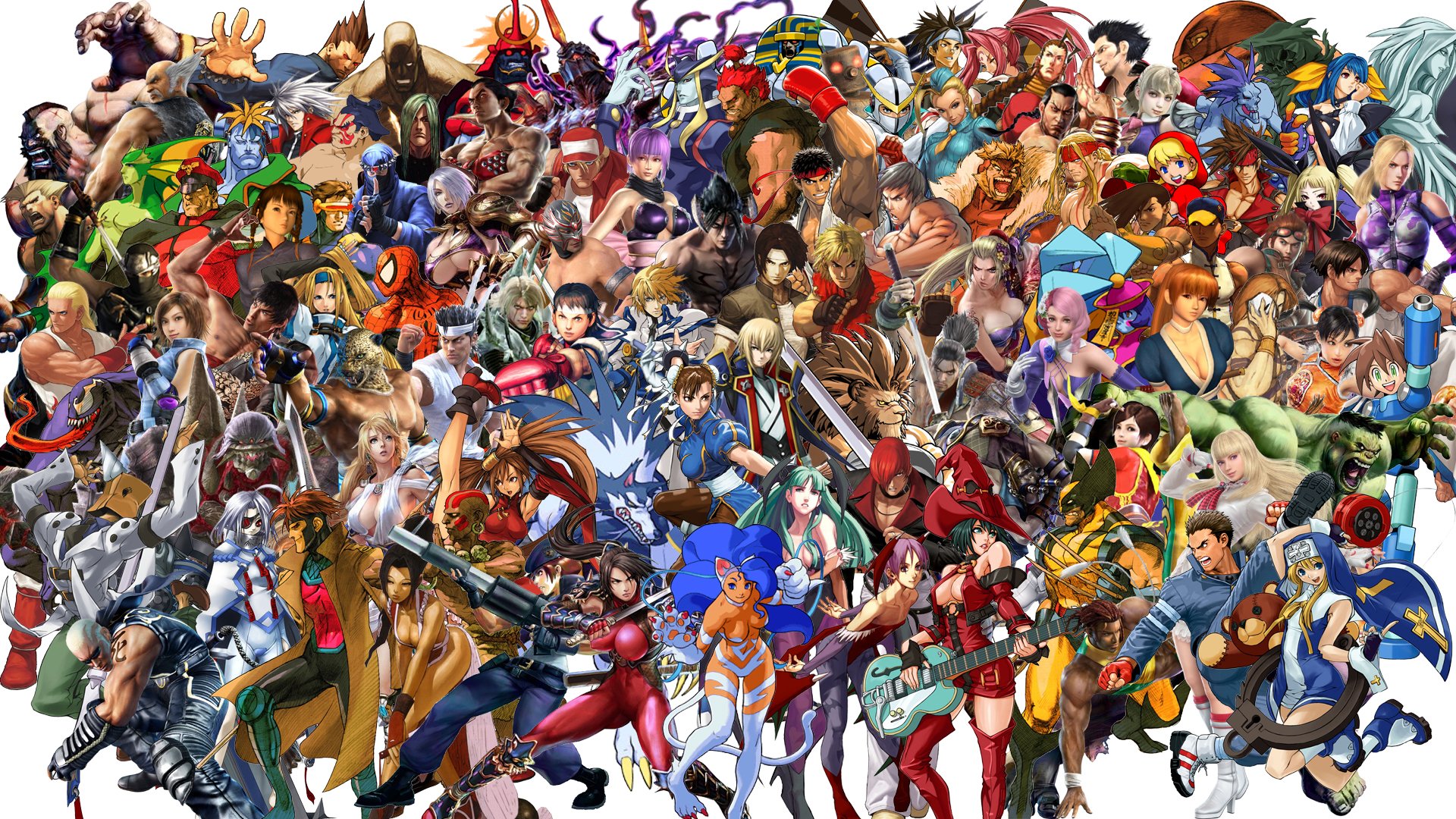About the Talk
The culture of fighting games — digital games of competitive martial arts-style combat—is one of the most interesting and contentious of gamer subcultures. This talk examines the influences and norms of that community, including its spiritual and physical roots in the arcade, common gameplay practices, and how issues of ethnicity and gender collide with gamer identity in the ‘FGC’.
Todd Harper is a researcher at the MIT Game Lab with a background in mass communication and cultural studies. His current research focuses on both competitive communities and their cultural norms, as well as queer and gender representation and issues in gaming culture.
The following is a rough account of the talk and Q&A.
Where it all began
Todd’s interest in games and gamer culture began in 2004 at EVO:
- Use of a really strict, difficult technique made the crowd go wild
- Research for this project began after viewing the video from the EVO championship and asking the question: “What is going on?”
- Fighting games allow players to challenge one another instead of cooperative play
This elicited a few questions:
- What was going on in the fighting game community?
- What are fighting games?
Theoretical Frameworks
- Gender performativity
- Situates identity within discourse
- Identity is something that we perform rather than something we “have”
- Different situations invoke different performances: sometimes resistant, sometimes not
- Gameplay as performance
- Not much work had been done on community members as subjects
- How does play affect how people identify themselves?
Todd explains that ethnographic work included attending the EVO tournament in 2009 and interviews with fighting game players in 2009 and 2010. First, Todd used used of a set of questions he developed prior to observation. Todd then recruited players through the community to participate in further questioning. He met a lot of of resistance as a threat to the community, particularly concerning issues with confidentiality and speaker credits. As Todd explained, “You learn about the culture by seeing how easy it is to get in touch with them.”
A bit of history: The Arcade
Arcades were a place for public play of video games in the 1980’s and 1990’s. However, they’re dying out in the US. We have moved away from public play. Home consoles moved play into the home instead of arcades. “Family fun center” and “Arcade Museums” are the remaining forms of the arcade. This is reflected in the changes you see in the arcade environment. Chinatown Fair, a famous arcade in NYC has been remade into a family fun center. The owner no longer thought the traditional business model was viable.
Fighting games echo the arcade of the past. The controllers used by players are referred to as arcade sticks. They are an item you need if you play fighting games. There is a physical advantage to using an arcade stick: greater range of motion and more control. Players design their own sticks. Two ends of the spectrum: utilitarian and cosmetic. They are a symbol for players which show someone’s interests through cosmetic enhancements. They are a membership badge. Arcade sticks show that a player is truly dedicated.
Arcades are Acculturating
All players Todd spoke with got their start in an arcade. Not all players are concerned with being the best. House rules developed for fairness and not being “cheap”. House rules are not good for tournaments and are thrown out in favor of “real” play. The community defines itself by the way that it plays. Instead of online tournaments, players have tournaments in person. They value the face to face interaction of the arcade setting and the process of “defending the honor” of the arcade.
EVO began in arcades. The event got large enough that there would not be enough machines in the nation to allow all the participants to play. They moved out of the arcade world, yet emulate it. Many players are too young to remember the arcade experience.
The Practice of Play
The idea of fairness and balance is incredibly important to fighting game players. They approve of play that is dramatic and skillful. The players want drama. The players want to see full matches.
It is considered good manners to allow the opponent to win the second game in a best of three. There are some practices that are frowned upon in the community:
- Ring out: knocking someone out of the ring is an instant win. A character in the game was booed at in event because her combination of moves was very easy to complete and offered no counter play.
- This character is considered to be broken: low risk, high reward.
- A balanced character offers high risk high reward gameplay.
- A “cheap” move has high payoff for very low risk.
- A broken character has no drawbacks.
Whole rooms of people will boo a “broken” character. Fighting game players are extremely concerned with fairness and balance. Skill should be the determining factor in a match. These games have created two camps: casual vs hardcore players.
Ethnicity Gender and Class
The FGC is fairly diverse in terms of race. The community is all about inclusion, but this ideal sometimes get eclipsed by rhetoric. In a conversation with a player about his ability to play fighting games, Todd was asked, “You don’t have Asian hands?” There is a Japanese “mystique”. Asian players are seen as inherently better. The community shares an orientalist vision of competence. There is a different attitude towards competitive e-sports in Asian nations, which is embodied in the form of Daigo Umehara, the Japanese god of fighting games. National identity is superseded by the desire for a “broken” character to not win.
Fighting Games and Gender
The community is overwhelmingly male. The women Todd met at EVO had arcade sticks which is the badge of DFG players, but he didn’t see them compete. Most were mothers, girlfriends, wives and supporters. The community has a strong belief in meritocracy, where the logic was: if you have skill you will rise to the top. However, skill can actually work against inclusion. The FGC is very hostile to women. Women become invisible at these events because of fear to compete.
Cross Assault Controversy
An example of blatant, on-air, sexual harassment at an event. A male player repeatedly harassed a female participant throughout the event. This player was not alone in his misogyny, he was responding to many live-stream viewers. The female player, Miranda, eventually threw a match so that she could leave the tournament since she was so uncomfortable. Tom Cannon wrote two articles “Back to Basics, Getting Beyond the Drama”: saying the FGC was fine and there was no issue. The next article “Hurtful Speech: Time to Take a Good Look in the Mirror”, written one day later, actually called out the FGC for its misogynistic tendencies. The two articles were released back to back and showed an extreme turn around. BurnUrBra is another example of a woman who is barraged by both misogynistic and racist slurs. EVO held a Women’s Invitational 2010 but there were concerns from women players about being sent to a ‘ghetto’ or being treated differently. Dividing women off for their own protection inspires very damaging rhetoric.
Conclusions
Fighting game culture reinforces the idea that player identity is a confluence of many factors:
- Historical and social context of play
- Social norms and normative play
- Collective knowledge production
- Intersectional influences
- Material influences
FGC is passionate and vibrant, but they have some complicated issues to work out. E-sports are a sanitized version of professional gaming that the FGC doesn’t want to be a part of. The FGC ‘wants’ to be messy and exclusive. This notion is in direct contradiction to their espousal of inclusion. Todd recalled a player saying, “Fighting games without sexual harassment is just Starcraft”. They are constantly working in the tension of engaging a broader set of players, but only on their terms.
Questions:
Jason:
I’m interested in how players choose their avatars, and issues of cross-gender identification. Do players choose one identity or juggle many? How do we see this practice? Is it liberating or objectifying, etc?
Todd:
Most players have a “main” that they play most of the time, and then an additional set of 3-4 characters that they play well. In general though, most players don’t see their characters in a gendered sense. Rather, they see them as an assemblage of tactics and capacities, not as gendered identities.
Desi:
Have you seen a shift in breakdowns in gender make up?
Todd:
I think this hasn’t changed much over time. There are still the same archetypal characters: nimble characters (women) and big, strong, slow men. Of course, there are exceptions, such as Arcana Hearts –that has all cute female characters.
Anime games are games that have a very strong “too Japanese” connotation in the gaming world. And there is much essentialist ethnic portrayals.
Jesse:
Do you find that community of players who have the arcade sticks to are willing to integrate new players. Can you compare it to the League of Legends community that tends to be very elitist?
Todd:
There is a stereotype that the internet makes people treat people worse, because people are more detached. However, often see players helping others realize how they may beat them with the idea being that the better the community is, the richer the community will be as a whole. However, there still are elitist communities where it’s very challenging to establish yourself in a new community, where you just do something amazing in order to establish yourself.
Eduardo:
What is your relationship in this community now?
Do you bring your observations to the community?
Todd:
I think that my access to the community may be lessened in many ways.
Other researchers have gotten a lot of harassment for their work. They are very resistant to change. The minute you call out a problem you are the enemy. A lot of them are very fine with the status quo. However, there are others who are interested in following the professionalized gaming world, are more interested in more progressive changes.
Hiromi:
You mentioned there are less women. However, in Japan, I see a lot of girls wearing those dresses and costumes that are referencing the games. Is there any subculture group of cosplayers here in the U.S.?
Todd:
Oh yeah, we have cosplayers too. We just don’t have as many. One, I think there are a lot more women in the community than we know about. Some work has been done on Xbox live and women in that situation. Women don’t feel comfortable in that space. Many women don’t reveal themselves as female and when they do, they face serious repercussions. Cosplayers are still fans but engage in the medium in a totally different way. They are a parallel track of fandom
As Japanese culture has become increasingly popular, we’ve seen a rise in cosplayers.
Yu:
Do the game companies support or sponsor or sue? Do they change in reaction to these communities?
Todd:
There is an immense amount of communication between developers and the FGC. When I was at the EVO in 2009, the director of Street Fighter 4 was there to talk to the people and show that he was there to listen to the players. Do we want to have our messy community or the sanitized version from other e-sports? Japanese companies will have location tests to have players come and give feedback on balance etc. They’re doing them in the US now as well. We now live in a console era where you can “patch” these games. There are many iterations of Street Fighter 2 but that was back before patching existed. Now developers can change the game on the fly and are much more observant of community desires.



